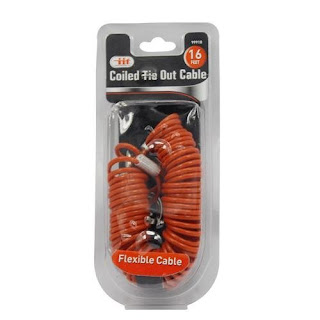Used properly, tie out cables
can be handy tools for keeping dogs safely in their own yards, camp sites, or
other spots. Such products offer an economical alternative to underground
leash-less pet containment systems, electronic collars, fences, or enclosed dog
runs.
Up front, I want to make it
clear that I do not recommend tying any dog up and leaving him unsupervised,
especially for long periods of time. And I do not espouse confining dogs with
chains, spiked collars, ropes, or other harsh methods.
Humane yard tie outs are
handy for quick potty breaks or for allowing a dog to keep his owner company
during yard or garden projects, car washing, picnics, beach times, or other
outdoor sessions. Employed in this manner, a tie out cable system can be quite
handy, preventing the dog from running out into the street or getting lost.
How does a tie out cable system work?
The tie-out cable system is
simple. It generally includes a corkscrew
stake or domed
spike that fits snugly into the ground,, as well as a flexible covered
cable (available in various lengths) that is equipped by a snap clip on
each end. Some cable systems are coiled, making them somewhat retractable. One
end of the tie out cable is clipped to the ground stake or spike (which usually
has a swiveling ring to prevent tangling). The other is affixed to the dog’s
collar.
We like the ground spike tie
out cable system much better than the tree-to-tree
or pole-to-pole tie out system, which can present a lynching hazard for a
pet.
What about coiled
tie out cables? Are they a best or a bust for dogs?
A coiled
tie out cable sounds like a great idea – at least, in theory. Because it is
designed to be retractable, it springs back into place and out of the way in
the yard when it is not in use. This may help to eliminate lawnmover run-overs
and cable destruction. It may minimize tripping hazards in the yard as well.
On the other hand, a coiled
tie out cable tends to snap quickly and sharply as soon as it is detached from
the pet’s collar. (I have to admit that I have been clocked more than once in
the arm or leg by this phenomenon.) It also seems to tug a bit on the dog’s
collar, when the animal moves about in the yard.
In addition, the coil seems
to whirl and tangle – much like a traditional coiled telephone receiver cord. After
a few uses, the coil doesn’t round up neatly. Instead, it bulges and bumps and
hits the ground in a jumbled mess.
In our yard, we like the uncoiled
tie out cables for another reason. When we unclip our dog from the system,
we try to leave the collar-clipping end of the cable on the edge of the
walkway. This means we can step outside barefoot, in socks, or in slippers –
without stepping on mud or damp grass in the early morning dew or after a rain.
When we tried the coiled cable, this was not the case. The cable always snapped
back to the ground spike, which was located way out on the wet grass.
We no longer purchase coiled
tie out cables, which usually cost a little more anyway. Our socks and slippers
stay dry.
Image/s:
Product promo photo/s
Fair use
Feel free to follow on Google Plus and Twitter. You are
invited to subscribe for free to my General
Pets Examiner column, so you will receive email notifications whenever new
articles appear.



Nice blog! I read you complete blog it is very informative and easy to read. A properly fitted leather dog collar should be comfortable and lightweight, allowing your dog to feel secure without hindrance. Even when additional moving accessories such as dog leashes, harness or backpack are used, a simple collar with ID retention is still recommended.
ReplyDelete